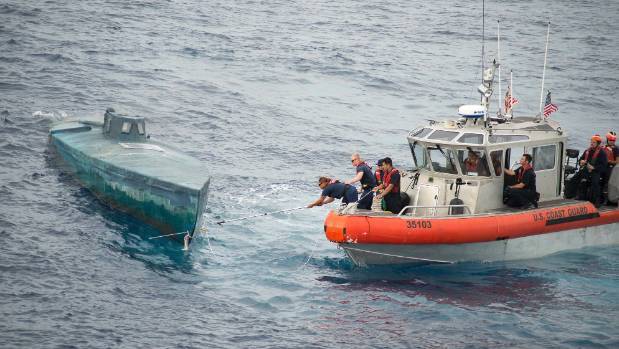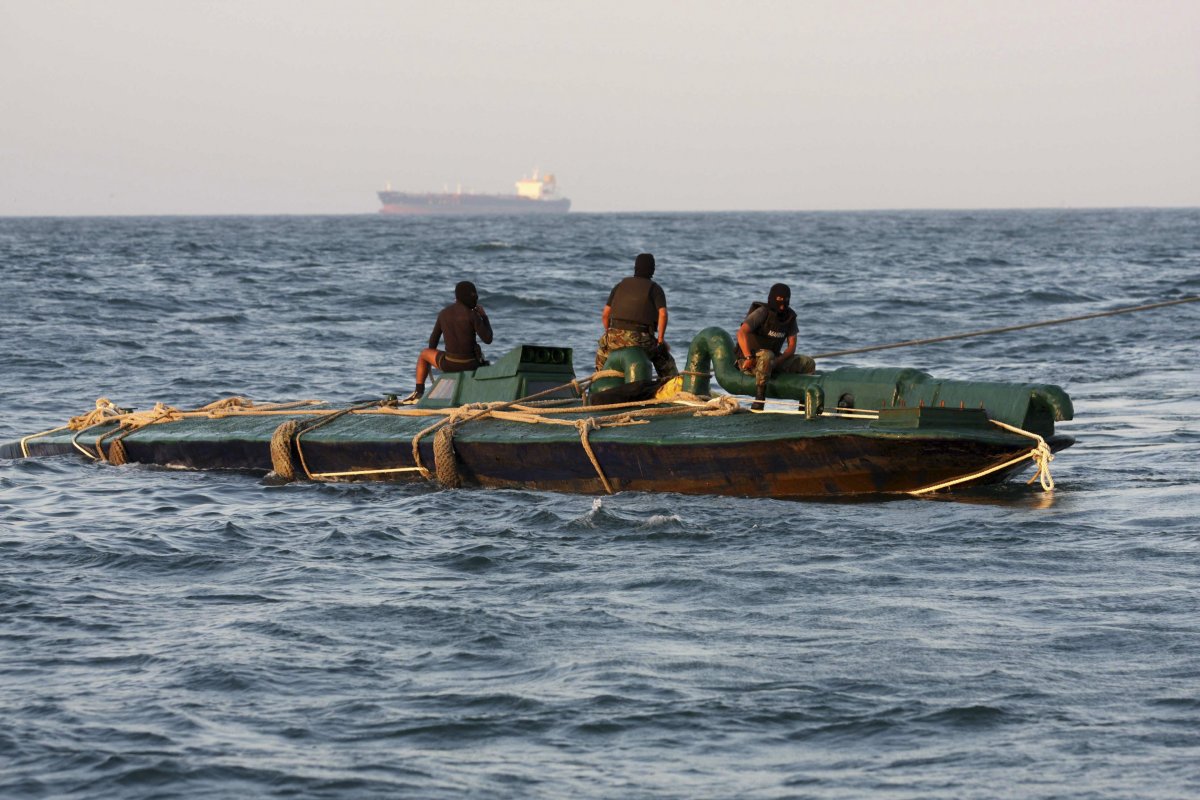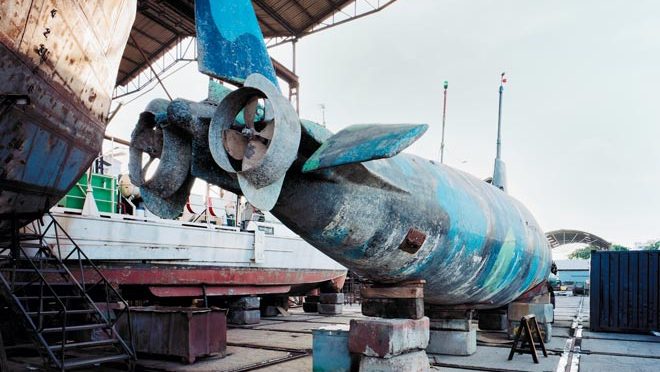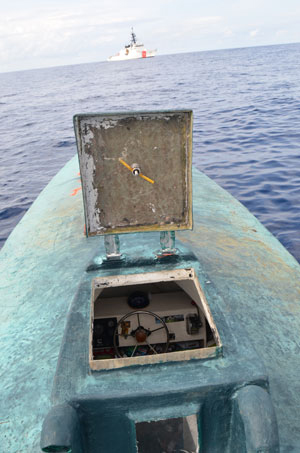By John Stryker
One year after the ratification of their historic peace agreement, the Colombian government and Fuerzas Armadas Revolucionarias de Colombia (FARC; Revolutionary Armed Forces of Colombia) continue to make joint steps towards the peaceful demobilization and assimilation of former FARC members into Colombian society. A few hiccups aside, the deal has seen the reintegration of over 7,000 former fighters into camps designed to facilitate their transition into society.1 While countless points regarding FARC’s innovation and longevity merit examination, one infrequently analyzed item stands out: FARC’s drug submarines. Drug submarines (hereafter referred to as narcosubmarines) are manufactured in the thick jungles of eastern Colombia and are not the primitive vessels of one’s imagination. FARC’s narcosubmarines boast sophisticated anti-detection features and navigation, can haul up to 10 tons of cocaine, and can cost upwards of ten million U.S. dollars. Narcosubmarine development has spurred many scholars into hazy gesticulations of narco-terrorism. This paper provides an expose of the issue and more thoroughly considers its implications.
The Development of Narcosubmarines
Narcosubmarines did not appear overnight. They are the technological byproduct of a shifty competitive relationship between trafficking groups and those that pursue them.2 As security forces improved their tracking strategies in the 1990s and 2000s, drug trafficking organizations (DTOs) responded in kind to avoid them. They are notoriously flexible. Once Caribbean mainstays, DTOs switched to Pacific trafficking routes to avoid detection. They often utilize other clever modes of cocaine transport, such as underwater containers bolted underneath the hulls of boats. Originally, creatively-named ‘go-fast’ boats were the first vehicles of choice in moving cocaine up the coasts of Central America. Yet improvements in radar surveillance as well as increased patrolling saw more speedboats interdicted. The development of sub-surface vessels became increasingly attractive. Sub-surface activity was first documented with the 1993 discovery of the ‘San Andrés’ self-propelled semi-submersible (SPSS) near the San Andrés islands of Colombia.3 A crude ship, it was smaller and slower than contemporary subs and could be easily spotted by air. SPSSs were soon supplemented by low profile vessels (LPVs), which avoid detection by riding just above water level. Meanwhile, the first fully-submersible submarine was discovered dense jungle terrain near the town of Facatativá, Colombia in 2000. This Russian-designed sub was not completed, but was predicted to feature advanced navigation equipment, a carrying capacity of 150-200 tons, and the ability to dive to over 300 feet underwater.4 While a precise estimate is impossible to establish, analysts have theorized that dozens of these subs are being churned out every year.5
Supremacy of the Submarines
While high-profile submarine seizures garner attention in the press,6 the combined efforts of U.S. and Central American governments have been unable to seriously address the overall stream of drugs.7
For one, drug trafficking events are extremely difficult to detect:
“American operations analysis shows that given good intelligence of a drug event and a patrol box of a certain length and width, a surface vessel operating alone has only a 5 percent probability of detecting (PD) that event. A surface vessel with an embarked helicopter increases the PD to 30 percent, and by adding a Maritime Patrol Aircraft to the mix, the PD goes up to 70 percent. Analysis by the Colombian Navy shows that adding one of their submarines to the mix raises the PD to 90 percent.”8
Even with the luxury of advanced warning, a resource-intensive, multi-faceted, and (ideally) intergovernmental effort is needed to make interception of the vehicle likely. Sufficient resources are not in place for these missions. Due to budget cuts, “SOUTHCOM is unable to pursue 74 percent of suspected maritime drug trafficking.”9 General John F. Kelly of the U.S. Southern Command (SOUTHCOM) lamented to Congress in 2014 that:
“I simply sit and watch it (drug trafficking) go by…”10
Further still, when narcosubs are actually interdicted, crew members will typically scuttle the vessel via a system of sophisticated drainage valves.11 Millions of dollars’ worth of evidence can be sunk in a matter of minutes. The recovery of cocaine then morphs into the recovery of the crew members which sank it. Although the United States’ Drug Trafficking Vessel Interdiction Act of 2008 now incriminates unidentified submarine crews for attempting to evade authorities, law enforcement cannot typically prosecute for the submarine and its cargo lying on the ocean floor.

Finally, in a general sense, interdiction is a problem of scale. 30 percent of the maritime flow of drugs from South America up through Central America is estimated to make use of narcosubmarines.12 Given that maritime routes are roughly estimated to account for 80 percent of drugs shipped north,13 narcosubmarines carry around 24 percent (0.8 x 0.3) of total product, almost a quarter of the entire drug stream. While a single narcosub interdiction may eradicate hundreds of millions of dollars’ worth of cocaine, DTOs’ diversified drug portfolio still renders their cost-benefit analyses profitable. Yet their innovation with respect to narcosubmarines poses challenges for more than the U.S. Coast Guard and regional partners. It raises compelling concerns for U.S. national security.
Narco-Terrorism?
The wealth garnered by DTOs undermines national security through the endemic corruption and poor rule of law it breeds in its host countries. Many DTOs are powerful enough to form pseudo-states, areas of military primacy (especially in rural or isolated areas) where centralized federal government authority is weak. In this vein, FARC has been characterized as possessing:
“…an enormous capacity to leverage economic resources, to control some territory, and to maintain a superficial presence in others…[as] their local, armed patronage and their ability to take advantage of rural youth unemployment keeps them afloat and even enables them to establish pockets of legitimacy and support in many regions of the country.”14
Narcosubmarines also pose international security threats. While a more sophisticated analysis of these threats may exist in the classified sphere, open source literature provides a useful primer of the issue. Lamentably, analyses of terrorism are always an exercise in a sort of speculative predication which may very well fail to materialize. A narcosubmarine-based attack on the United States might be shelved as a ‘black swan’ event, a game-changing development difficult to even contrive hypothetically.15 Still, a number of points are difficult to dismiss. Three factors must be considered: the establishment of motive, the acquisition of a narcosub, and the execution of an attack.
Motivations
Many scholars have posited that South America provides fertile ground for terrorist groups and their ideologies. While some have cited widespread disaffection amongst Latin America’s citizenry as a possible motive for terrorism, frustrations with policy, inequality, corruption, and other shortcomings related to governance provide conditions that promote insurgencies. A 2016 congressional report on the subject noted that “most terrorist acts occur in the Andean region of South America,” specifically FARC and the National Liberation Army (ELN) in Colombia and the Shining Path (SL) in Peru.16 Kidnappings, attacks on infrastructure, and the killing of civilians and local authorities are common tactics. With a focus on domestic politics, grassroots terrorism has not accompanied drug shipments in their northward journeys to countries like the United States. Latin America does not present the United States with extreme, anti-Western ideological sentiments common in other regions afflicted with insurgency. Nor is the measurable level of anti-Americanism amongst the general populace especially high.17
Putting domestic terrorism aside, the intersection of foreign terrorist organizations (FTOs) and DTOs must subsequently be considered. FTOs have been active in South America in their own right. Two bombings of the Israeli embassy and the Argentine-Israeli mutual association took place in Argentina the early 1990s.18 Venezuela has been frequently accused of collaborating with Iran and funding extremist groups like Hezbollah, which holds documented connections with FARC.19 Russian engineering was responsible for the birth of the Facatativá sub, and Russia has maintained connections with the Cali cartel, another Colombian DTO.20 In 2001, three members of the Irish terrorist group the Provisional Irish Republic Army (PIRA) were arrested for “training FARC militants in the use of explosives, including homemade mortars.”21 FARC utilized this kind of training in its subversive campaigns against Colombian urban centers. Most importantly, South America’s security framework has difficulty preventing these kinds of events. Counterterrorism efforts with respect to FTOs have been plagued by “corruption, weak government institutions, insufficient interagency cooperation, weak or non-existent legislation, and a lack of resources.”22 In this globalized environment, the insertion of FTOs into the narcosubmarine context is entirely plausible.
While terrorist attacks in Latin America are relatively infrequent and usually domestic in nature, the combination of weak government authority in isolated regions and verified connections to well-established terrorist organizations cannot conclusively rule out the possibility of a group plotting a narcosubmarine-enabled attack on the United States.
Submarine Acquisition
On a basic level, the acquisition of a narcosubmarine is a purely pecuniary issue. Given a prospective buyer operating near the location of the submarine and the means to negotiate an exchange, purchasing technological blueprints or the submarine outright would only require a monetary transfer. Yet the story is much more complex. First, in all likelihood, terrorist organizations would need to purchase an entire sub. Obtaining the necessary materials and chartering the technological know-how to bring them together would be burdensome and time-consuming. At best, the finished products – which would also require familiarity with local supply chains and the tropical terrain – would be far inferior to the original submarine models. Secondly, Donald Davis stresses that for a DTO such as FARC, the “opportunity cost of a single voyage could exceed $275 million USD.”23 In other words, DTOs would need to reap a profit greater than that which the sub could otherwise garner, calculated to approach a whopping three hundred million dollars. These sums are well beyond the means of the wealthiest terrorist organizations. Further still, a successful terrorist strike on the United States would immediately engender “a swift and decisive military response…[that] could significantly alter the DTO’s ability to function…”24 Inciting retaliatory measures would cut into profits if not totally destroy the DTO. In this way, the chartering of a narcosubmarine appears beyond the means of even the most fanciful ITO.
The most compelling threat is the break-up of FARC, a wild-card variable that presents an uncertain trajectory. FARC’s demilitarization has created a power vacuum in rural Colombia. The Colombian NGO Indepaz has predicted “a territorial reorganization of the ‘narco-paramilitary groups’ in the aftermath of a peace accord with the FARC with the Bacrim (Spanish acronym for ‘bandas criminales’) groups vying to take over FARC drug and illegal mining businesses.”25 Relegated to the peripheries26 under FARC, these groups are competing amongst themselves for dominance in the emerging power vacuum. According to the Internal Displacement Monitoring Center (IDMC), fighting amongst competing groups “has resulted in more than 56,000 displacements in the first half of 2017.”27 These paramilitary organizations include the Ejército de Liberación Nacional (ELN; National Liberation Army) and the Ejército Popular de Liberación (EPL; Popular Liberation Army), as well as a host of smaller gangs. Even indigenous communities — many of which are hostile to the federal government and its efforts to eradicate coca production — are prone to violence.28 At least one narcosubmarine has been produced post-demilitarization.29 In July, the Colombian military seized a narcosubmarine built by the ELN.[30] With the opportunity generated by FARC’s retirement and less formalized, looser hierarchical structures, peace agreements with these organizations a la FARC appears unlikely.31 Finally, one must consider FARC’s organizational structure. Prior to the settlement, FARC was “divided into six different commands, each composed of at least five fronts that represent different geographic territories,” all relatively decentralized and autonomous.32 Breakdown of the structural hierarchy raises the probability that individual members33 transfer submarine technology to external agents. When not trafficking cocaine, the aforementioned cost-benefit scenario changes: why not profit from the sale of idle narcosubmarines or the jungle laboratories that built them? Like the ‘loose nukes’ unaccounted for after the breakup of the USSR, control of narcosubmarines, the expertise related to their production, and their assembly sites post-accord is unclear. With FARC’s abdication and continued power swings amongst old and emerging groups in present-day Colombia, the sale of a loose narcosub remains a serious concern.
Although DTOs and FTOs have many reasons to shun technological exchanges, the uncertainty with respect to changing power dynamics amongst sub-national groups in Colombia today cannot rule out FTO acquisition of a narcosubmarine.
Execution of an Attack
How might a drug submarine be used in a terrorist attack? Transportation and detonation of a weapon of mass destruction (WMD) would clearly represent the gravest of scenarios. On paper, many narcosubs are large enough to carry a WMD.34 Delivery on the water additionally allows submarines to reach urban centers on both the East and West Coasts. Yet the list of prohibitive hurdles involved in such an endeavor is enormous, the most pressing of which are not specific to submarines. The use of narcosubmarines for improvised attacks is most concerning.
Described by Admiral James Stavridis in 2008 as “…clearly the next big thing,”35 autonomous narcosubmarine technology has outpaced anti-submarine defenses. They are particularly difficult to expose. Kenneth Sherman notes that “submerged submarines are detected almost exclusively acoustically, and unlike the louder Soviet nuclear subs of the Cold War, modern diesel-electric submarines are extremely difficult to detect, localize, and track.”36 The electric subs FARC regularly employed37 are “virtually impossible to detect using passive acoustic measures.”38 Amid sequestration and budget cuts, the U.S. Coast Guard’s defenses are even less likely to detect and neutralize a narcosubmarine on their own.

An attacking blueprint could take many forms. In 2000, the USS Cole was rammed by a small boat laden with explosives.39 Seventeen Americans were killed and scores more injured in this suicide attack. An attack on a Navy vessel like the USS Cole in this style is altogether feasible.40 A sub-surface approach with a large payload could do even more damage with little to no warning. In this sense, U.S. harbors on both coasts could be susceptible. And the target need not be military-affiliated. Large groups of people (often headed by and including American citizens) frequent cruise ships which regularly traverse the Caribbean and Pacific coastline. These cruise ships are bulky, difficult to maneuver, and possess no inherent defense systems. Stavridis reiterates the point: cruise ships are ‘lucrative’ targets for terrorists.41 Total destruction of a cruise ship, the worst-case scenario, could result in hundreds of deaths and almost $2 billion dollars’ worth of damages.42 The fallout from such an event would be unprecedented. Even a failed attack with respect to cruise ships could send worldwide cruise markets into sharp decline, as evidenced by the infamous ‘Poop Cruise’ of 2013.43
Above all, the definitive features of a terrorist attack are the reverberations it induces in society. Here narcosubmarines would add a unique and powerful twist to the panic. As Davis dryly remarks, “the overall shock value would be stunning.”44 Submarines possess a tangible mystique which borders on enchantment. Gliding silently along the depths of the ocean, submarines represent a sort of impalpable yet eerily present threat, alarming if activated. In the public eye, characterization of a narcosub attack could read as follows:
A lone submarine built painstakingly by hand in the dense jungles of South America by a demilitarized non-state entity traveled thousands of miles north utterly undetected to successfully strike the shores of the United States, which boasts the strongest and most technologically advanced Navy of all time.
Given the improbable establishment of motive and the acquisition of the necessary technologies, a submarine-based terrorist attack on the United States is not inconceivable given the scenarios considered here and envisaged elsewhere.45
Conclusions
Given the difficulties charting modern submarines post-USSR,46 the security forces of the United States should pay special attention to the evolving world of external submarine development by non-state actors. Narco-terrorism in Colombia follows a fairly intuitive procedural logic on paper. While the idea may seem far-fetched, prudent U.S. policy should continue to plan for the possibility of such an attack.
John Stryker is a senior studying International Relations and Hispanic Studies at the College of William and Mary.
Bibliography
Austin, Christina. “Disaster Timeline: How Carnival Went from ‘Fun Ship’ To ‘Poop Cruise’.” Business Insider. February 20 2013. Web. <http://www.businessinsider.com/how-carnival-went-from-fun-ship-to-poop-cruise-2013-2>.
Baker, Andy, and David Cupery. “Gringo Stay Here!” Americas Quarterly. Spring 2013. Web. <http://www.americasquarterly.org/gringo-stay-here>.
Cragin, Kim, et al. “Sharing the Dragon’s Teeth: Terrorist Groups and the Exchange of New Technologies.” RAND. 2007. Web. <https://www.rand.org/content/dam/rand/pubs/monographs/2007/RAND_MG485.pdf>.
Crisp, Wil. “The New Struggle for Colombia’s Countryside after FARC.” Al Jazeera. October 24 2017. Web. <http://www.aljazeera.com/news/2017/10/struggle-colombia-countryside-farc-171023111815468.html>.
Davis, Donald. “The Submersible Threat to Maritime Homeland Security.” Naval Postgraduate School. September 2013. Web. <https://calhoun.nps.edu/handle/10945/37609>.
Farley, Robert. “Submarines, Cocaine, and Aquatic Terrorism?” Prospect. June 11 2009. Web. <http://prospect.org/article/submarines-cocaine-and-aquatic-terrorism>.
Ferkaluk, Brian. “Latin America: Terrorist Actors on a Nuclear Stage.” Global Security Studies. Fall 2010. Web. <http://globalsecuritystudies.com/Ferkaluk%20Latin%20America.pdf>.
Jaramillo, Michelle. “The Revolutionary Armed Forces of Colombia (FARC) and the Development of Narco-Submarines.” University of South Florida Scholar Commons. Web. <http://scholarcommons.usf.edu/jss/vol9/iss1/6/?utm_source=scholarcommons.usf.edu%2Fjss%2Fvol9%2Fiss1%2F6&utm_medium=PDF&utm_campaign=PDFCoverPages>.
Kraul, Chris. “Colombia Has a Peace Deal, but Can It Be Implemented?” LA Times. March 13 2017. Web. <http://www.latimes.com/world/mexico-americas/la-fg-colombia-peace-outlook-2017-story.html>.
Pelcastre, Julieta. “Colombian Military Forces Attack Drug Trafficking in Operation Barbudo.” Dialogo Americas. October 6 2017. Web. <https://dialogo-americas.com/en/articles/colombian-military-forces-attack-drug-trafficking-operation-barbudo>.
Perez, Janelle. “Fighting Terrorism with Foreign Aid: A Case for Continued US Assistance in Latin America.” John Hopkins. January 5 2015. Web. <https://jscholarship-library-jhu-edu.proxy.wm.edu/handle/1774.2/37232>.
Ramirez, Byron, and Robert Bunker. “Narco-Submarines: Specially Fabricated Vessels Used for Drug Smuggling Purposes.” Scholarship at Claremont. 2015. Web. <http://scholarship.claremont.edu/cgi/viewcontent.cgi?article=1029&context=cgu_facbooks>.
Ramirez, Byron. “Narco-Submarines: Drug Cartels’ Innovative Technology.” CIMSEC. August 2 2014. Web. <https://cimsec.org/narco-submarines-drug-cartels-innovative-technology/12314>.
Sherman, Kenneth. “Mini-Subs: The Next Terrorist Threat?” ProQuest. July 2003. Web. <https://search-proquest-com.proxy.wm.edu/docview/206603319?pq-origsite=summon>.
Sullivan, Mark, and June Beittel. “Latin America: Terrorism Issues.” Federation of American Scientists. December 15 2016. Web. <https://fas.org/sgp/crs/terror/RS21049.pdf>.
Szoldra, Paul. “A Retired Navy Admiral is ‘Very Concerned’ about Terrorists Attacking Cruise Ships.” Business Insider. June 30 2017. Web. <http://www.businessinsider.com/stavridis-terrorist-attacks-at-sea-2017-6>.
“U.S. Coast Guard Intercepts Semi-Submersible Vessel Packed with 3,800 Pounds of Cocaine.” USA Today. December 11 2017. Web. <https://www.usatoday.com/story/news/nation-now/2017/12/11/u-s-coast-guard-intercepts-semi-submersible-vessel-packed-3-800-pounds-cocaine/939668001/>.
Vargas, Ricardo. “The Revolutionary Armed Forces of Colombia (FARC) and the Illicit Drug Trade.” TNI. June 7 1999. Web. <https://www.tni.org/en/publication/the-revolutionary-armed-forces-of-colombia-farc-and-the-illicit-drug-trade>.
Watkins, Lance. “Self-Propelled Semi-Submersibles: The Next Great Threat to Regional Security and Stability.” Naval Postgraduate School. June 2011. Web. <https://calhoun.nps.edu/bitstream/handle/10945/5629/11Jun_Watkins.pdf?sequence=1&isAllowed=y>.
References
[1] Kraul, “Colombia Has a Peace Deal, but Can It Be Implemented?”.
[2] Ramirez, “Narco-Submarines: Drug Cartels’ Innovative Technology.”
[3] Note that SPSSs are not true submersibles, although they are equally difficult to detect, as discussed further on; Ramirez and Bunker, “Narco-Submarines: Specially Fabricated Vessels Used for Drug Smuggling Purposes,” 29.
[4] IBID, 34.
[5] IBID, 12.
[6] “U.S. Coast Guard Intercepts Semi-Submersible Vessel Packed with 3,800 Pounds of Cocaine.”
[7] Note that “the Coast Guard is the lead federal agency for maritime drug interdiction in the transit zone, responsible for the apprehension of cocaine transporting vessels …”; Wakins, “Self-Propelled Semi-Submersibles: The Next Great Threat to Regional Security and Stability,” 6.
[8] Ramirez and Bunker, “Narco-Submarines: Specially Fabricated Vessels Used for Drug Smuggling Purposes,” 47.
[9] IBID, 7.
[10] IBID, 7.
[11] After successful missions, the vessels are also sunk this way; IBID, 25.
[12] IBID, 7.
[13] IBID, 6.
[14] Vargas, “The Revolutionary Armed Forces of Colombia (FARC) and the Illicit Drug Trade.”
[15] Davis, “The Submersible Threat to Maritime Homeland Security,” 39.
[16] Sullivan and Beittel, “Latin America: Terrorism Issues,” Summary.
[17] Baker and Cupery, “Gringo Stay Here!”.
[18] Ferkaluk, “Latin America: Terrorist Actors on a Nuclear Stage” 115.
[19] Davis, “The Submersible Threat to Maritime Homeland Security,” 24.
[20] IBID, 24.
[21] Cragin et al., “Sharing the Dragon’s Teeth: Terrorist Groups and the Exchange of New Technologies,” 71.
[22] Perez, “Fighting Terrorism with Foreign Aid: A Case for Continued US Assistance in Latin America,” 52.
[23] Davis, “The Submersible Threat to Maritime Homeland Security,” 45.
[24] IBID, 45.
[25] Sullivan and Beittel, “Latin America: Terrorism Issues,” 4.
[26] Although significant actors with notable histories in their own right.
[27] Crisp, “The New Struggle for Colombia’s Countryside after FARC.”
[28] IBID.
[29] It is impossible to predict how many narcosubs continue to be produced. Retroactive seizures, as seen with sporadic interdictions of drug subs since the 1990s, are a poor proxy for an overall estimate.
[30] Pelcastre, “Colombian Military Forces Attack Drug Trafficking in Operation Barbudo.”
[31] Crisp, “The New Struggle for Colombia’s Countryside after FARC.”
[32] Jaramillo, “The Revolutionary Armed Forces of Colombia (FARC) and the Development of Narco-Submarines,” 53.
[33] Especially those hard-liners unwilling to participate in the surrender, or even de-militarized members wishing to return the previous way of life given difficulties reintegrating into everyday society.
[34] Davis, “The Submersible Threat to Maritime Homeland Security,” 42.
[35] Watkins, “Self-Propelled Semi-Submersibles: The Next Great Threat to Regional Security and Stability,” 51.
[36] Sherman, “Mini-Subs: The Next Terrorist Threat?”.
[37] Davis, “The Submersible Threat to Maritime Homeland Security,” 25.
[38] Sherman, “Mini-Subs: The Next Terrorist Threat?”.
[39] Farley, “Submarines, Cocaine, and Aquatic Terrorism?”.
[40] IBID.
[41] Szoldra, “A Retired Navy Admiral is ‘Very Concerned’ about Terrorists Attacking Cruise Ships.”
[42] Davis, “The Submersible Threat to Maritime Homeland Security,” 52.
[43] Austin, “Disaster Timeline: How Carnival Went from ‘Fun Ship’ To ‘Poop Cruise’.”
[44] Davis, “The Submersible Threat to Maritime Homeland Security,” 39.
[45] Jane’s Terrorism and Security Monitor’s “Insurgent Submersibles” provides a favorable (albeit subscription-based) account of the issue.
[46] See James Moltz’s piece “Submarines and Autonomous Vessel Proliferation: Implications for Future Strategic Stability at Sea.”
Featured Image: Seized narcosubmarine (Christoph Morlinghaus)




![9 July 2015 Seizure of Narco Submarine U.S. Coast Guard Image from Video [FOR PUBLIC RELEASE] U.S. Agencies Stop Semi-Submersible, Seize 12,000 Pounds of Cocaine 94th Airlift Wing, U.S. Coast Guard Pacific Area. DVIDS/DMA, 19 July 2015.](https://cimsec.org/wp-content/uploads/2015/11/sub2.jpg)

